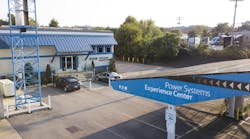Generator Design Debate: Insurer vs. Engineer
Some insurance companies are now asking their clients to install 165°F fusible links (valves) in the fuel oil supply (FOS) line between the main storage tank and day tank(s). In some cases, the companies are also asking for the links to be placed in the fuel oil return (FOR) line. The single reason for this is that “if there were a fire in the generator room, the fuel supply to the generator(s) room would be shut down and therefore the chance of a ‘burn down’ minimized.”
We think this advice is debatable, depending on a number of factors. These include but are not limited to:
1. Whether the FOR line returns fuel to main tank or day tank.
2. Elevation of main tank as opposed to day tank and generator(s).
3. Day tank(s) volume.
4. Number of day tanks and generators being supplied from a single source of fuel.
5. Whether the links can be monitored for open/close setting.
6. Control options for locking out fuel pumps at main tank, or day tank, to prevent pumps from trying to force fuel through FOS fusible links when day tank lo-level sensors call for pumps to start.
7. How the lo-fuel and hi-fuel relays are calibrated and whether they can be automatically overridden with the accidental closure of a fusible link.
Other considerations could include:
1. The presence of an electric fire pump, which depends on the generator for emergency power (if the generator starts because of a normal power failure this could be important).
2. Whether the generator room is fully sprinkled.
3. In the case of multiple generators, the advisability of installing FOS fusible links between the main tank and each day tank.
The closure of an FOS valve/link to the day tank will only shutdown the generator after the fuel in the day tank is depleted. If the FOR is plumbed to the day tank, this could take up to 2 hr (depending on volume). If the FOR is plumbed to the main tank, the time would be shorter.
The closure of an FOR fusible link while the generator is running, no matter where the FOR line is plumbed, could result in fuel system damage. According to one generator manufacturer engineer, “As far as a shut off valve in the return line, that’s not good. On some gen-sets, there are warnings about this. If the FOR valve is closed, the fuel pressure can go dangerously high, causing fuel filter housings to burst. I never like to see any type of valves or restrictions in the return line.”
Fusible links are well named in that they become an extra link in a chain that could break, and, in this case, result in the failure of the EPSS to provide power when needed. I wonder if these insurance companies aren’t more concerned about claims for damaged equipment than the safety of staff and patients protected by the EPSS.
Testing of fusible links becomes another issue. This is a labor-intensive process because the only way to test the unit is to heat the link until it melts, check the closure, and then replace the melted link. I don’t see that happening on a regular basis.
To add a little irony to the issue, there is a new paragraph in NFPA 20, 2013 edition that states:
“9.6.2.2: The generator shall run and continue to produce rated nameplate power without shutdown or derate for alarms and warnings or failed engine sensors except for shutdown.”
Note that shutting off the fuel supply is not mentioned in this statement.
A second paragraph states:
“9.6.2.3: The generator fuel supply capacity shall be sufficient to provide eight hours of fire pump operation at 100% of the rated pump capacity in addition to the supply required for other demands.”
The Technical Committee responsible for NFPA 99 and 110 should address this issue in upcoming editions. Some believe that a locked manual valve in the FOS — and possibly the FOR depending on elevation — as well as compliance to NFPA 110, 5.6.5.6 would suffice instead of fusible links. The text in this standard states:
“5.6.5.6: All installations shall have a remote manual stop station of a type to prevent inadvertent or unintentional operation located outside the room housing the prime mover, where so installed, or elsewhere on the premises where the prime mover is located outside the building.”
MGI welcomes comments for group discussion. I view this as an enigma, wrapped in a riddle, surrounded by mystery.
Chisholm, president of MGI Consulting, Orlando, Fla., has provided emergency power supply systems (EPSS) consulting services and education to more than 1,500 health care facilities. He serves as a member of the National Fire Protection Association's Technical Committee responsible for NFPA 110, Emergency and Standby Power Systems and the Electrical Section of NFPA 99, Health Care Facilities. He also serves as a primary emergency power consultant to the U.S. Army Medical Department (AMEDD) and the Department of Defense.


